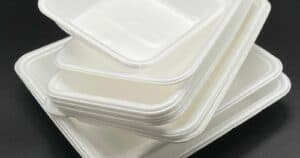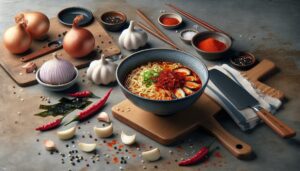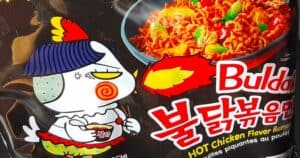Ramen noodles are an obsession for good reason – they’re affordable, convenient, and downright delicious. But let’s be real, these wavy noodles aren’t winning any health food awards.
If you’re a ramen fan looking to upgrade your snack, you might wonder: does draining ramen noodles actually make them healthier?
The answer isn’t so simple. Draining the sodium-loaded broth can reduce some salt, but it also removes flavor, changes texture, and concentrates artificial additives. While draining helps a bit, there are better ways to give your ramen a nutritional reboot.
In this article, we’ll explore the science behind draining ramen noodles. You’ll learn how it impacts sodium levels, texture, and overall nutrition. We’ll sniff out the truth on better options for healthy ramen enjoyment, from alternative noodles to veggie power-ups. Get ready to slurp up some ramen knowledge!
The Ramen Nutrition Rundown
First, a quick look at what’s actually in those wavy noodles:
- High in sodium – One pack can contain over 50% of your daily value. Too much sodium isn’t good for your heart.
- Low in nutrients – Ramen lacks fiber, protein, vitamins. It’s not going to win any nutritional prizes.
- High in fat – All that oil makes ramen tasty, but too much saturated fat isn’t healthy.
- Fillers and preservatives – Many instant ramens contain MSG, artificial flavors, and colors.
So ramen isn’t exactly a superfood. But could draining it make a difference? Let’s investigate.
Does Draining Ramen Reduce Sodium?
This is the big question. Here’s the science behind draining and sodium:
- Broth contains lots of sodium – The seasoned broth is the biggest sodium source, not the noodles.
- Draining removes broth – By pouring out the broth, you are ditching a major sodium delivery system.
- Potential sodium reduction: 30-40% – Draining broth can cut the sodium by almost half in some tests.
- But noodles still have some sodium – Don’t forget the noodles themselves absorb some sodium during processing.
The verdict? Draining can significantly reduce the sodium hit. But ramen will still have some salt without the broth.
Other Impacts of Draining Ramen
Draining ramen impacts more than just salt. Here are other effects to know:
- Alters texture – Noodles may become gummier or clump more when drained. The broth contains starches that impact texture.
- Changes flavor – With broth gone, seasoning directly coats noodles rather than dispersing throughout. Flavor profile shifts.
- Concentrates artificial flavors – Draining can intensify fake flavors, sweeteners and MSG left clinging to noodles.
- Removes some nutrients – Broth contains small amounts of minerals that are lost when drained away.
- Makes noodles harder to digest – Broth helps “lubricate” noodles for digestion. Draining removes this lubrication.
The impact depends on your preferences! But good to understand the broader effects.
Healthier Ways to Enjoy Ramen
Draining ramen can remove some sodium. But it’s not a perfect health solution. Here are better tips for healthy ramen:
Choose Lower-Sodium Options
- Check labels for reduced sodium brands under 500mg per serving.
- Opt for unseasoned instant ramen and flavor yourself.
- Make “scratch” ramen with fresh noodles and homemade broth.
Use Less Seasoning
- Start with half a packet and add more to taste.
- Boost flavor with garlic, ginger, sesame oil instead of all seasoning.
Pack in Veggies
- Add mushrooms, baby spinach, carrot slivers, etc for nutrients.
- Zoodles (zucchini noodles) make a veggie “pasta” base.
Lean Protein Power
- Poach an egg right in the broth for protein + creaminess.
- Add pre-cooked chicken breast, shrimp or tofu.
Alternative Noodles
- Try noodles made from brown rice, quinoa or chickpeas. More fiber!
- Zucchini or butternut squash noodles = low cal and sodium.
Should You Drain Your Ramen?
Questions remain about draining away the broth:
Does it reduce sodium? Yes, draining can remove a significant amount of sodium. But some remains in noodles.
Is it worth the texture/flavor change? That’s personal preference! Some love concentrated flavor on noodles.
Is it actually healthier? Simply draining ramen doesn’t suddenly make it healthy. Limiting sodium intake is beneficial, but ramen should be enjoyed in moderation as part of an overall balanced diet.
The verdict? If you do drain your ramen, balance it by loading up with vegetables, lean protein, and healthier noodles. But skipping the broth isn’t a miracle health solution!
Tips for Healthy Ramen Habits
Here are some final tips for keeping your ramen enjoyment in check:
- Choose low-sodium varieties when possible. Check labels!
- Use only half the seasoning packet or make your own broth.
- Add lots of veggies for fiber, vitamins and bulk.
- Complete the meal with side dishes like boiled eggs, kimchi or edamame.
- Enjoy ramen as an occasional treat, not an everyday meal. Everything in moderation!
Ramen can be part of healthy eating with some simple tweaks. But for everyday meals, emphasize veggies, lean proteins and complex carbs. Now go slurp up that ramen!





